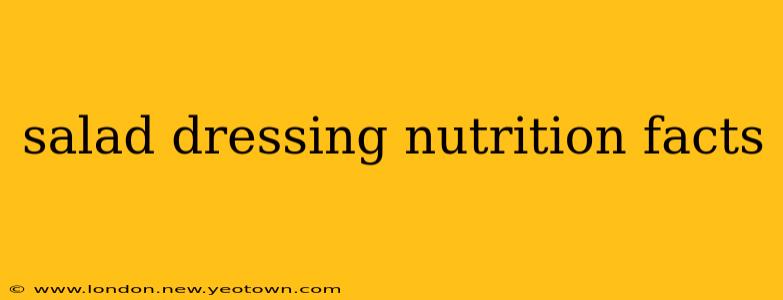Let's be honest, the vibrant greens and colorful veggies in your salad are only half the story. The other half, often the more impactful half, is the dressing. That creamy, tangy, or zesty drizzle can dramatically alter the nutritional profile of your healthy meal, boosting its calorie count, fat content, and even sodium levels. Understanding salad dressing nutrition facts is crucial for mindful eating and maintaining a balanced diet. This isn't about eliminating dressings altogether; it's about making informed choices that support your health goals.
What are the typical nutritional components of salad dressings?
Most salad dressings are a blend of oils (often vegetable, canola, or olive oil), vinegar or other acidic ingredients (like lemon juice), and various seasonings. However, the specifics vary wildly depending on the type of dressing. Creamy dressings, for example, incorporate dairy products like mayonnaise or sour cream, significantly increasing their fat and calorie content. This often translates to a higher saturated fat content as well. Conversely, vinaigrette-style dressings, which are typically oil and vinegar based, are generally lower in calories and fat. The addition of sugar, sweeteners, and thickeners further impacts the nutritional profile.
How many calories are in a typical serving of salad dressing?
This is a tricky question, as serving sizes and the type of dressing massively impact the calorie count. A typical serving size is often around 2 tablespoons, but many people unknowingly use more. A 2-tablespoon serving of a creamy ranch dressing can easily contain 150-200 calories or more, whereas a similar serving of a light vinaigrette might only contain 50-80 calories. Always check the nutrition label for the specific calorie count of the dressing you are using. This is where mindful portion control is critical.
How much fat, saturated fat, and sodium is typically in salad dressings?
Fat content varies considerably. Creamy dressings are high in fat, often exceeding 10 grams per serving, with a significant portion being saturated fat. Vinaigrettes, thanks to their oil-and-vinegar base, are typically lower in fat, but the type of oil used influences the overall composition. Sodium is another crucial factor. Many commercially produced dressings are quite high in sodium, contributing to potential health concerns if consumed regularly in large quantities. Reading the nutrition facts panel is crucial to assess the fat and sodium content of your chosen dressing.
Are there healthier options for salad dressings?
Absolutely! Making your own salad dressings at home offers complete control over the ingredients. You can use heart-healthy oils like olive oil or avocado oil, reduce the added sugar, and control the sodium content. This allows you to create delicious and nutritious dressings that align perfectly with your dietary preferences. Alternatively, look for commercially produced dressings that are lower in calories, fat, saturated fat, and sodium. Check the ingredient list to avoid those with excessive added sugars or unhealthy additives.
What are some tips for choosing healthy salad dressings?
- Read the label carefully: Pay close attention to serving sizes, calories, fat, saturated fat, and sodium content.
- Choose dressings with healthy oils: Look for dressings made with olive oil, avocado oil, or other heart-healthy oils.
- Limit added sugars: Opt for dressings with minimal added sugars or natural sweeteners.
- Watch out for sodium: Choose dressings with lower sodium content to manage your sodium intake.
- Consider making your own: Homemade dressings offer maximum control over ingredients and nutritional value.
By understanding the nutrition facts and making informed choices, you can enjoy the deliciousness of salad dressing without compromising your health. Remember, the key is balance and moderation. A little dressing can add flavor and enjoyment to your salad, but mindful consumption is key to reaping the benefits of your healthy meal.

